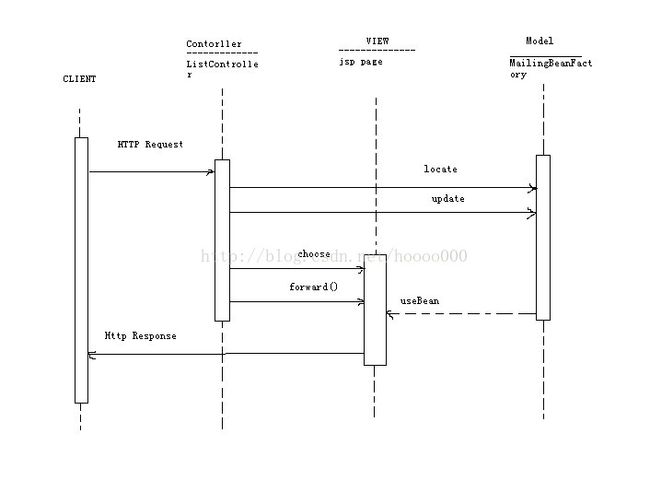J2EE的MVC模式
在J2EE设计模式一书中的第三章看到了MVC模式,并给出了Email注册的例子来详细阐释但没有详细代码,就动手写了一下以期更好地理解MVC模式,顺便复习下零星学的jsp.
文献:J2EE设计模式 William Crawford JonathanKaplan。CH3表达层
http://en.wikipedia.org/wiki/JavaBeans
工程位置:Lomboz /MVCBean_v0.1
在mysql中新建了数据库maildata,该数据库中建了表mail.
maildata.sql:
create database maildata;
use maildata;
create table mail(
id int primary key auto_increment,
first varchar(255),
last varchar(255),
email text
);
insert into article values(null,'Biang','Hoo','[email protected]');
描述:模拟一个邮箱的注册过程
客户端:
client的登录界面subscribe.html:
Subscribe
服务器端的用户接口MVC
MVC将用户接口问题分割成三个截然不同的部分:模型,视图和控制器。模型存储应用的状态,视图解释模型中的数据并将它展示给用户,最后控制器处理用户的输入,然后或者更新模型或者显示新的视图
Controller:控制器的工作包括:1.读取请求,
2。协调到模型的访问,
3存储用于视图的模型信息,
4将控制转给视图。
一般为servlet,控制业务逻辑:在本例中为ListController并体现了上述四点功能
import javax.servlet.ServletException;
import javax.servlet.http.*;
import javax.servlet.*;
import bean.MailingBeanFactory;
import java.io.IOException;
/**
* @author Bangwen Chen
*
* 2013-8-5
*/
public class ListController extends HttpServlet {
public static final String FIRST_PARM = "first";
public static final String LAST_PARM = "last";
public static final String EMAIL_PARM = "email";
public static final String MAILINGBEAN_ATTR = "mailingbean";
protected void doGet(HttpServletRequest req, HttpServletResponse resp)
throws ServletException, IOException {
String first = req.getParameter(FIRST_PARM);//读取请求
String last = req.getParameter(LAST_PARM);
String email = req.getParameter(EMAIL_PARM);
MailingBeanFactory mb = MailingBeanFactory.newInstance();//协调到模型的访问
mb.setFirst(first);
mb.setLast(last);
mb.setEmail(email);
req.setAttribute(MAILINGBEAN_ATTR,mb);//存储用于视图的模型信息
boolean result = mb.doSubscribe();
String nextPage = "/success.jsp";
if(!result){
nextPage="/failure.jsp";
}
RequestDispatcher dispatcher = getServletContext().getRequestDispatcher(nextPage);//将控制转给视图
dispatcher.forward(req,resp);
}
}
Model:模型,模型的设计是以数据为中心的,在J2EE的世界里,模型通常是JavaBean或EJB,
JavaBean是java中可以重复使用的组建,实际上,他们就是一些把许多对象放到一个对象(就是Bean)的类。他们是序列化的,即可以直接被IO操作,必须有不带参数的构造函数,并且可以通过getter和setter方法来访问属性。JavaBean
不要写成裸体类,而是应该包含在包中。它的优点有:1,write once,run anywhere 2,暴露给其他应用的属性,事件和方法是可控的。。。等等
在本例中为MailingBeanFactory,负责与数据库的连接及操作,为了方便对数据库进行操作还使用了以前封装过DB类用于数据库的连接,代码如下:
package bean;
import java.sql.*;
/**
* @author Bangwen Chen
*
* 2013-7-15
*/
public class DB {
public static Connection getConn(){
Connection conn =null;
try{
Class.forName("com.mysql.jdbc.Driver");//MySQL
conn=DriverManager.getConnection("jdbc:mysql://localhost/maildata?user=root&password=admin411");
//Class.forName("oracle.jdbc.driver.OracleDriver");//ORACLE
//conn=DriverManager.getConnection("jdbc:oracle:thin:@GG:1521:orcl","scott","admin411");
}catch(ClassNotFoundException e){
e.printStackTrace();
}catch(SQLException e){
e.printStackTrace();
}
return conn;
}
public static Statement getStmt(Connection conn){
Statement stmt=null;
try{
if(conn!=null){
stmt = conn.createStatement();
}
}catch(SQLException e){
e.printStackTrace();
}
return stmt;
}
public static PreparedStatement getPreStmt(Connection conn,String sql){
PreparedStatement preStmt=null;
try{
if(conn!=null){
preStmt = conn.prepareStatement(sql);
}
}catch(SQLException e){
e.printStackTrace();
}
return preStmt;
}
public static ResultSet getRS(Statement stmt,String sql){
ResultSet rs =null;
try{
if(stmt != null){
rs=stmt.executeQuery(sql);
}
}catch(SQLException e){
e.printStackTrace();
}
return rs;
}
public static void closeConn(Connection conn) {
try {
if(conn != null) {
conn.close();
conn = null;
}
} catch (SQLException e) {
e.printStackTrace();
}
}
public static void closeStmt(Statement stmt) {
try {
if(stmt != null) {
stmt.close();
stmt = null;
}
} catch (SQLException e) {
e.printStackTrace();
}
}
public static void closePreStmt(PreparedStatement preStmt) {
try {
if(preStmt != null) {
preStmt.close();
preStmt = null;
}
} catch (SQLException e) {
e.printStackTrace();
}
}
public static void closeRs(ResultSet rs) {
try {
if(rs != null) {
rs.close();
rs = null;
}
} catch (SQLException e) {
e.printStackTrace();
}
}
}
package bean;
public interface MailingBean {
/**
* @author Bangwen Chen
*
* 2013-8-5
*/
//first name
public String getFirst();
public void setFirst(String first);
//last name
public String getLast();
public void setLast(String last);
//email
public String getEmail();
public void setEmail(String email);
//
public boolean doSubscribe();
public String getErrorString();
}
实现类MailingBeanFactory
package bean;
import java.sql.*;
/**
* @author Bangwen Chen
*
* 2013-8-5
*/
View:jsp,更新用户视图本例中实现了success.jsp failure.jsp。
success.jsp
<%@ page import="bean.*"%>
<%@ page language="java" contentType="text/html; charset=UTF-8"
pageEncoding="UTF-8"%>
Subscription Results
Dear
Congratulations!! the address
<%@ page import=bean.*%>
<%@ page language="java" contentType="text/html; charset=UTF-8"
pageEncoding="UTF-8"%>
Subscription Results
Dear
I am sorry to tell you that the address
the problem was: I'm too lazy to write the code,so I just omit it......
tomcat中的部署:
webapps下新建了mail目录【WEB-INF(lib,classes),web,xml】
整个流程 :客户端访问subscribe.html;并填写注册信息然后发送给控制器(ListController),控制器读取用户请求,更新模型(MialingBeanFactory)存储状态,并取得用于视图的模型信息,然后根据模型的更新结果将控制转给视图,视图将对应的页面(注册成功/失败)返回给用户。。
